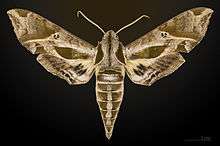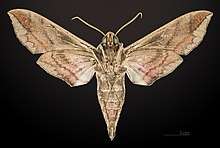Eumorpha satellitia
Eumorpha satellitia, the satellite sphinx, is a moth of the family Sphingidae. The family was first described by Carl Linnaeus in 1771. It lives from Brazil and northern Argentina north through Central America, Mexico, and the West Indies to south Texas and southern Arizona.[2]
| Satellite sphinx | |
|---|---|
 | |
| Dosral view | |
 | |
| Ventral view | |
| Scientific classification | |
| Kingdom: | Animalia |
| Phylum: | Arthropoda |
| Class: | Insecta |
| Order: | Lepidoptera |
| Family: | Sphingidae |
| Genus: | Eumorpha |
| Species: | E. satellitia |
| Binomial name | |
| Eumorpha satellitia | |
| Synonyms | |
| |
The wingspan is 114–134 mm. Adults are on wing from April to August and then again in October. They feed on the nectar of various flowers, including Petunia hybrida, Saponaria officinalis and Lychnis alba.
The larvae feed on Cissus pseudosicyoides and Cissus rhombifolia. Pupation takes place underground.
Subspecies
- Eumorpha satellitia satellitia (Jamaica and from Mexico, Belize, Guatemala to Ecuador and further south into Bolivia, Brazil and Uruguay)
- Eumorpha satellitia excessus (Gehlen, 1926) (Brazil)
- Eumorpha satellitia licaon (Cramer, 1775) (extreme southern Texas, Mexico, Nicaragua and Costa Rica south to Brazil to Bolivia and Paraguay)
- Eumorpha satellitia posticatus (Grote, 1865) (Cuba and the Bahamas)
Gallery
 E. s. excessus - dorsal view
E. s. excessus - dorsal view E. s. excessus - ventral view
E. s. excessus - ventral view E. s. licaon Male - dorsal view
E. s. licaon Male - dorsal view E. s. licaon Male - ventral view
E. s. licaon Male - ventral view E. s. licaon female - dorsal view
E. s. licaon female - dorsal view E. s. licaon female - ventral view
E. s. licaon female - ventral view Female E. s. posticatus - Female dorsal view
Female E. s. posticatus - Female dorsal view Female E. s. posticatus - Female ventral view
Female E. s. posticatus - Female ventral view Male E. s. posticatus - Male dorsal view
Male E. s. posticatus - Male dorsal view Male E. s. posticatus - Male ventral view
Male E. s. posticatus - Male ventral view
gollark: mwahahaahahahahahhaaaahahahaaaa
gollark: ++delete competence
gollark: Maybe you could use monads.
gollark: Neat.
gollark: ```rust#![forbid(unsafe_code)]fn main() { println!("Hello, world!");}```
References
- "CATE Creating a Taxonomic eScience - Sphingidae". Cate-sphingidae.org. Archived from the original on 2012-11-13. Retrieved 2011-10-26.
- "Eumorpha satellitia satellitia". Sphingidae of the Americas. June 10, 2014. Archived from the original on 2015-04-15. Retrieved 2011-10-26.
External links
- Lotts, Kelly & Naberhaus, Thomas (2017). "Satellite sphinx Eumorpha satellitia (Linnaeus, 1771)". Butterflies and Moths of North America. Retrieved December 10, 2018.
This article is issued from Wikipedia. The text is licensed under Creative Commons - Attribution - Sharealike. Additional terms may apply for the media files.